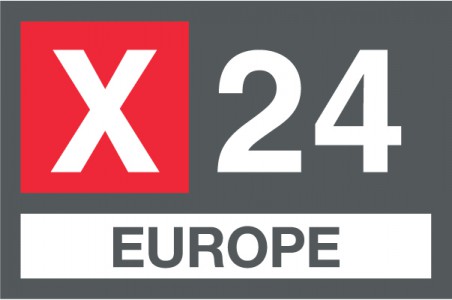Purpose of X24 Europe
To conduct a robust virtual online exercise that demonstrates the effective use of social media, crowdsourcing and collaboration tools in an innovative and cost-effective cloud computing environment. The exercise will focus on the exchange of actionable real-time information and build partner organizations’ awareness regarding response to simulated humanitarian assistance and disaster relief (HADR) crises in the European theater.
Background
On 24-25 September 2010, the Immersive Visualization Center (VizCenter), San Diego State University, California, hosted a virtual HADR event called “Exercise X24”. X24 involved over 12,500 people from 79 nations and 90 U.S. government, non-government organizations, and public/private partners in a collaborative environment using crowdsourcing, social media, and cloud computing applications. This was the first time a collaborative HADR exercise of this scale occurred online and integrated into real events. EUCOM is hosting X24 Europe, the next evolution of X24 scheduled for five-days in March 2011.
What to Expect
The X24 Europe scenario is complex with a simulated seismic event that generates a tsunami in the Adriatic and damage to key resources and critical infrastructure in the Balkans. The focus of X24 Europe will be in the utilization of “no cost” off-the-shelf online tools to gather, coordinate, and provide assistance to help thousands of victims and help save lives
Open Invitation to Formal and Informal Networks
All formal and informal groups across the globe are welcome to actively participate or observe X24 Europe, either on-site in Stuttgart, Germany or virtually, with emphasis on the following key stakeholders:
Governments of European partner nations
Other municipal, regional, and national governments
Non-government public/private organizations
Academic institutions
Volunteer Technology Communities
Schedule of Events
Initial Planning Conference (IPC) – December 1, 2010, San Diego, CA
Mid Planning Conference (MPC) and MSEL Conference- January 2011, San Diego, CA
Final Planning Conference (FPC) – February 2011, Stuttgart, GER
X24 Europe Execution – March 2011, Stuttgart, GER
Scenario Part I: Tsunami in the Adriatic Sea
A simulated magnitude Mw 7.0 thrust-fault earthquake strikes the coastline south of Bar, Montenegro. The earthquake migrates west to east through Montenegro to impact key resources and critical infrastructure in Montenegro, Albania, Kosovo, and Macedonia.
The resultant tsunami, while not large, will be large enough to cause damage the eastern Italian coastline, inundate lowlands, the Venetian Lagoon, and Trieste Lagoon. A minimum of an extra ½ meter of water will strike these areas, in multiple waves, over a period of hours. Dr. V. Malacic and B. Petelin, M. Sci. of the Morska Bioloska Postaja, Piranand, Slovenia modeled a tsunamigenic event in the Adriatic Sea using a Mw 6.8 Earthquake at Bar, Montenegro. The modeling concluded an expected wave amplitude of ≤ 0.40 meter is expected to impact the Gulf of Trieste. To view the progress of the Adriatic tsunami.
Scenario Phase II- Earthquake Damage to the Balkans
Port cities and villages in Albania, Montenegro, Bosnia, Croatia, Slovenia, and Italy will suffer damage to sea port infrastructures and vessels that remain in port. On land, damage from the Mw 7.0 earthquake and follow-on after shocks of decreasing magnitude will impact key resources and critical infrastructure in Montenegro, Albania, Kosovo, and Macedonia. The impacts of these events will be exacerbated by construction techniques not designed to withstand seismic events. Post-earthquake fires, as a result of gas line breaks, will also challenge participants.
The Challenge for Participants
The communication, coordination, and logistics challenges to develop an effective damage-risk-needs assessment, deliver aid to displaced populations requiring survival infrastructures, and facilitate evacuations will be hindered by the terrain, damage to sea port facilities, damage to roadways and bridges, loss of bulk power, inconsistent to non-existent bandwidth, pre-existing social, economic, and political challenges in the region.
X24 Europe will also simulate key resource and critical infrastructure destruction sympathetic to the scenario in and around Stuttgart, Germany to facilitate a collaborative exploration of innovative technologies.
Rules of Engagement
This is a “no fault” environment where participants are free to explore potential solutions.
Participant collaborations, decisions, and actions may not reflect policy, practice, procedure, or previous agreement and are not a commitment of policy, practice, procedure, or agreement.
All participants must be self-funded and are responsible for any and all expenses related to planning, implementation, and recovery from their activities related to X24 Europe.
All activities related to X24 must be safe and legal to be considered a part of this event.
All verbal and email communications related to X24 Europe during this event will include “This is an EXERCISE and not an actual event in the language of the recipient of the communication”. This message must be in the language of the recipient of the communication.
All Twitter and Facebook communications must start EX – NOT REAL prior to any message and include the hashtag #X24.
For Participant Registration and Questions
Contact x24europe@inrelief.org with your or your organization’s interest in participation.


